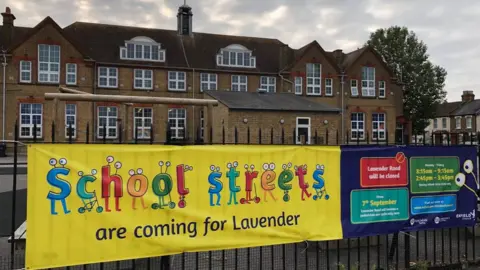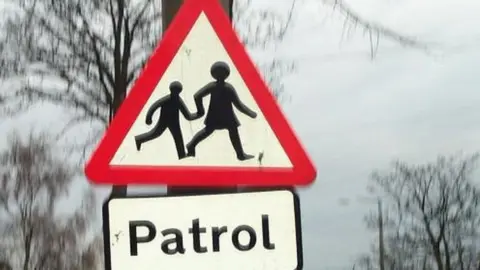School Streets scheme 'an easy win for the environment'

 BBC
BBCIf you were to visit a primary school, you're likely to see roads closed off during school drop off and pick up.
I recently visited Lavender Primary School in Enfield in north London, where teachers in hi-vis jackets set up barriers to stop cars and vans travelling through the road.
Compared to the usually hectic drop off, it is now a calm and pleasant environment.
Kids scoot, cycle and walk up to the school gates.
These are 'School Streets' and seem to be a less controversial scheme compared to the more contentious Low Traffic Neighbourhoods (LTNs). Although some of the time they are used in conjunction together.
Modal shift
And its popularity is growing across London.
I remember seeing the first one in Camden in 2017. New funding means they have increased dramatically.
Another 430 have been planned in the city at a cost of £4.08m.
Of those, 127 schemes have been set up - costing about £10,000 each.
So what do they do? They reduce pollution around schools and increase road safety.
Teachers say within one week of the scheme beginning, they have seen an increase in schoolchildren walking to school.
It seems the scheme is a good way to get what transport planners call "modal shift" - when people switch transport modes.
They also embody a subtle shift in attitude towards cars. The programme sends out the message that it is not acceptable to drive your child to school.

Enfield councillor Ian Barners told me he has had very few complaints about the streets around schools.
Who can argue about providing a clean, safe environment for schoolchildren and getting them to walk to school?
However, despite LTNs having many supporters, they also have some opponents.
'Moral high ground'
LTNs really try and get people to change habits through making driving inconvenient as well as making the alternative - walking and cycling - more attractive.
Many who live in LTNs love them. Others do not and think driving through residential areas is acceptable.
What "School Streets" have - which LTNs do not - is the moral high ground.
Schoolchildren should not be subjected to dangerous polluted roads.
To seriously change the mindset and encourage active travel School Streets seems a very easy win.
